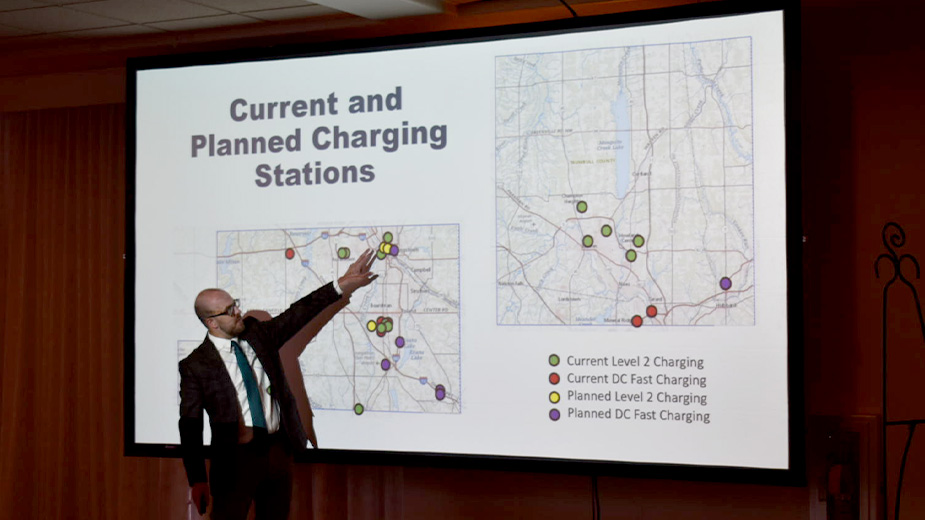Chamber Director Emphasizes Need for EV Infrastructure
POLAND, Ohio – Despite leading the nation in investment by the electric vehicle industry, Ohio ranks relatively low in investment in EV infrastructure, a Youngstown/Warren Regional Chamber official advised Wednesday.
David Wilaj, director of the chamber’s Mahoning Valley Logistics Council, shared insights on EV infrastructure investment statewide and locally during a presentation to the Western Reserve Port Authority’s board of directors.
More than $10 billion has been invested in EV and related manufacturing, including more than $2 billion in Trumbull County between Ultium Cells and Foxconn, and Wilaj said he expects that investment to continue.
Meanwhile, Ohio ranks 32nd among the states for total chargers with 2,824, or with one charger per 4,163 residents, he reported. Ohio’s ranking is even worse when it comes to the Level 3 chargers, or chargers that can completely charge a battery in less than an hour, placing 45th. The state has 451 fast chargers, or one for every 26,067 residents.
Mahoning and Trumbull counties combined have about 30 existing or planned chargers, including just three fast-charging stations currently and eight planned.
“For one charger, you’re looking at least $500,000,” he said. Installation also would require extensive onsite electrical revamps. Service stations offering EV chargers make about $6 per full charge off customers.
One of the main sources for EV charging stations is the National Electric Vehicle infrastructure program. The program provides 80% of the funds required for expenses related to installations, including last acquisition, he said.
Over the next five years, Ohio will receive a total of $140 million in NEVI funds to support the installation of EV charging stations.
Last month, state and Federal Highway Administration officials announced funding for 27 fast-charging stations across Ohio, the first round of such funding, though none were announced for the Mahoning Valley. Of the 27 selected, 17 were private gas stations.
FHA approved three interchanges in the area where the funding could be used. The logistics council engaged with partners including Eastgate Regional Council of Governments to identify local fuel station partners, but no local entities were interested in installing the infrastructure at their facilities, he said.
“Even the 20% is a big number,” WRPA board member Ed Muransky suggested. “If they’re in the right area, and EV’s are continuing, maybe [the port authority] should be the catalyst.”
Anthony Trevena, WRPA executive director, pointed out that service stations like Pilot and Buc-ee’s aren’t making money off what they sell customers though EV chargers or fuel pumps.
“They’re going to come in your store and they’re going to buy your overpriced burritos and drinks and things like that. They’re making more money at that,” he said.
Wilaj also pointed to a community charging and fueling grants program that provides between $500,000 and $15 million, with a 20% match, to install EV infrastructure accessible on any public road or publicly accessible location. The funding is available to states, metropolitan planning organizations, local governments, districts, public and port authorities, Indian tribes, or U.S. territory, state or local authorities that own publicly accessible transportation facilities.
Engineering firms and companies that do the installations say the transformers needed for the charging stations are a year and a half out, Wilaj said. “So even if you do get this grant, you’re probably up to at least two years before they’re installed anyway,” he added.
Also during the meeting, which was held at the Lake Club, WRPA board members approved moving forward on assisting three development projects, including one that called for entering into a cooperative agreement with a neighboring port authority.
The board approved authorizing execution of a term sheet and indemnity agreement for a capital lease for the Inn at Saybrook, a nearly $17 million, 69,400-square-foot senior assisted living center being developed in Columbiana by EDM Management Inc. The center would have 79 units, at least 25 of which will be dedicated to memory care.
The port authority previously worked with Boardman-based EDM to develop two other local senior centers.
“They will start construction upon execution of this lease and plan to be completed by June,” Trevena said.
Just before entering into the agreement with EDM, the port authority approved entering into a cooperative agreement with the Columbiana Port Authority to allow WRPA to work with EDM on the project in Columbiana. The Columbiana County Port Authority board approved the agreement Tuesday.
WRPA offered to let CCPA do the project with EDM, but CCPA declined because it doesn’t do capital leases, and EDM was a past client of WRPA, Trevena noted.
The other term sheet and indemnity agreement the port authority approved Wednesday was for the $11.5 million light industrial warehouse that ground was broken on Tuesday at West Warren Industrial Park.
“This is a project that is being built by our community by various investors so that we have Class A industrial space that we can be using,” Trevena said. “We have companies we turn away because we don’t have buildings.”
The port authority also approved execution of final lease documents for Trailstar’s 88,000-square-foot expansion in Smith Township. The project is expected to create 80 jobs and retain 85 jobs. Under the agreement, the port authority will sell an industrial revenue bond of up to $12.5 million to provide financing for the project.
Additionally, the port authority board renewed WRPA’s cooperative agreement with the city of Youngstown and authorized the purchase of just over 31 acres of property near the Youngstown-Warren Regional Airport, which the port authority operates, for a total of $375,000 from two separate owners.
Pictured at top: David Wilaj, director of the Youngstown/Warren Regional Chamber’s Mahoning Valley Logistics Council.
Copyright 2024 The Business Journal, Youngstown, Ohio.



